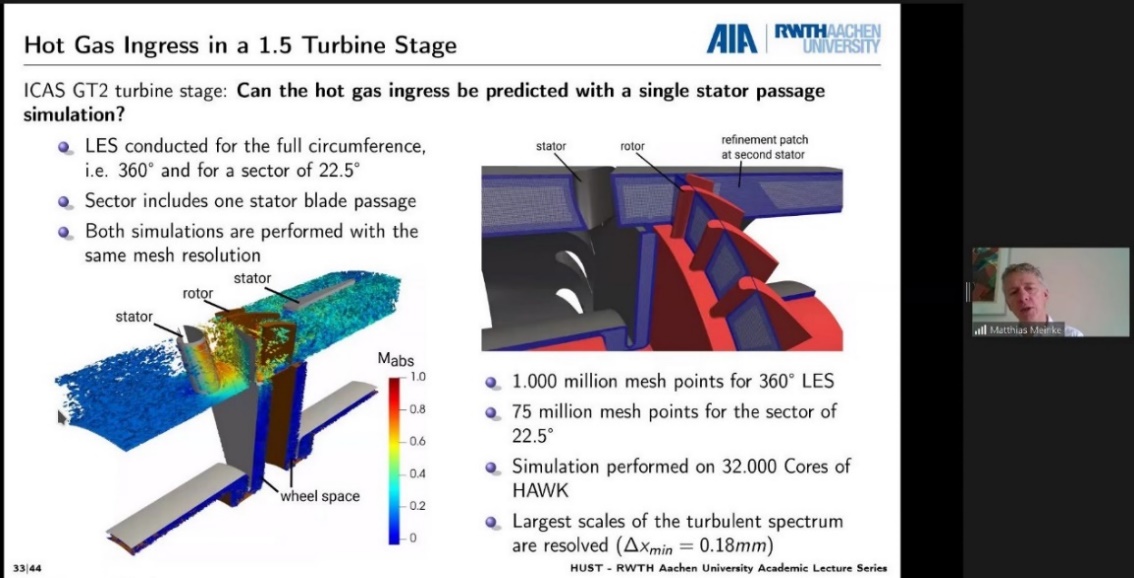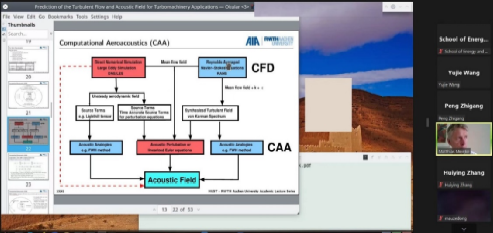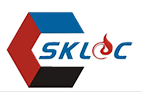On June 29th, HUST-RWTH Academic lecture on “Prediction of the Turbulent Flow and Acoustic Field for Turbomachinery Applications” was held successfully. Invited by Prof. Jun Wang, Professor of the School of Energy and Power Engineering, HUST, Dr. Matthias Meinke made a speech online. He is the chief scientist and team manager of the CFD department of the Institute of Aerodynamics RWTH Aachen University. Presided over by Prof. Jun Wang, the lecture was attended by over 1000 audiences from HUST, Northwestern Polytechnical University, and domestic and foreign universities.

Dr. Matthias Meinke delivering a speech

Offline venue for the lecture
During the speech, Dr. Meinke first introduced the basic information about RWTH Aachen University and the advanced research conditions of the Institute of Aerodynamics. Then, the basic principles, current trends, and wide applications of Computational Fluid Dynamics (CFD) were presented, beginning with turbulence, a complex flow phenomenon. Based on his team’s research findings in recent years, Dr. Meinke presented the fantastic turbulent structure inside the airfoil wake and turbomachinery, such as compressors and fans, and shared his precious experience in research. In addition, Dr. Meinke introduced the basic principles of the finite volume method and lattice Boltzmann method in CFD and demonstrated the latest application of the CFD solver independently developed by his team in Large Eddy Simulation (LES) of the flow field in turbomachinery with rich examples.

Dr. Matthias Meinke sharing his research findings
Starting from the harm of noise, Dr. Meinke introduced the source and classification of aerodynamic noise in turbomachinery. He focused on the development history and research status of Computational Aeroacoustics (CAA). He pointed out that we usually need to solve the flow sound source through CFD and then calculate the noise propagation by the CAA method to predict aerodynamic noise. After comparing the advantages and disadvantages of Direct Numerical Simulation (DNS) and Ffowcs Williams and Hawkings (FW-H) acoustic analogy, he proposed the Reynolds-Averaged Navier-Stokes (RANS) simulation results combined with the Amiet model to predict the far-field noise and gave an example of noise prediction for an axial fan. Finally, Dr. Meinke described the basic principles of two data processing algorithms, Proper Orthogonal Decomposition (POD) and Dynamic Mode Decomposition (DMD), and their applications in the nuanced analysis of complex internal flow in turbomachinery.

Q & A session
In the Q & A session, participants discussed with Dr. Meinke such as shared platform, Construction of grids, the calculation of LES, and the judgment of simulation results. Dr. Meinke was pleased to share relevant platforms and welcomed cooperation with scholars. He pointed out that obtaining a reasonable flow field depends not only on a large number of experimental data but also on rich engineering and simulation experience.
This lecture provided scholars with a platform to exchange academic findings, particularly broadening the participants’ outlook, and knowing about the international frontiers of this field. They obtained valuable experience in the internal flow of turbomachinery, numerical simulation and analysis of noise, which inspired scholars for their future research.




